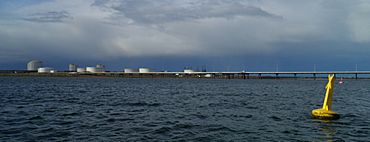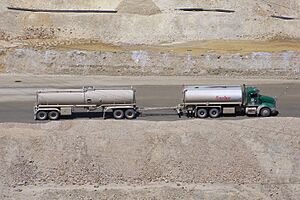Port Bonython facts for kids
Quick facts for kids Port BonythonSouth Australia |
|||||||||||||||
|---|---|---|---|---|---|---|---|---|---|---|---|---|---|---|---|

Port Bonython gas-loading wharf with Santos' gas fractionation plant in the background.
|
|||||||||||||||
| Established | circa 1982 | ||||||||||||||
| Postcode(s) | 5601 | ||||||||||||||
| Time zone | ACST (UTC+9:30) | ||||||||||||||
| • Summer (DST) | ACDT (UTC+10:30) | ||||||||||||||
| Location | 221 km (137 mi) from Adelaide CBD | ||||||||||||||
| LGA(s) | City of Whyalla | ||||||||||||||
| State electorate(s) | Giles | ||||||||||||||
| Federal Division(s) | Grey | ||||||||||||||
|
|||||||||||||||
Port Bonython is a special area in South Australia with a deepwater port. It is located west of Point Lowly in the Upper Spencer Gulf region. This place is about 16 km east-northeast of Whyalla and around 370 km north-west of Adelaide, the state's capital city.
Port Bonython is home to a gas processing plant and a diesel storage facility. The port's wharf is 2.4 kilometres long. It can handle large ships that carry up to 110,000 tonnes of cargo. The wharf was built in 1982 and named after John Bonython. He was the first chairman of a company called Santos.
Contents
What is Port Bonython?
A gas processing plant, run by Santos, started operating at Port Bonython in 1982. This plant and its storage tanks get crude oil and gas from the Cooper Basin in outback South Australia. They process these products and then send them out.
Port Bonython is the end point of a long pipeline called the Moomba to Port Bonython Liquids Pipeline. This pipeline is 659 km long. From Port Bonython, Santos ships these processed products by sea to customers across the Asia-Pacific region.
The 2.4 km long wharf was built by the Government of South Australia. It cost $48.2 million and was bought in 1983. The first shipments from the facility happened that same year. The wharf was officially opened on September 5, 1984, by the Premier of South Australia, John Bannon. The government helps maintain the jetty for Santos.
In 1992, there was an oil spill at Port Bonython. This happened when a ship called Era was docking. About 300 tonnes of heavy fuel leaked into Spencer Gulf. The spill caused harm to bird life and damaged important mangrove habitats and tidal creeks.
In May 2016, a new company called Port Bonython Fuels started operating. This meant Santos was no longer the only big industrial company there. Some other development plans from different companies were announced but later cancelled.
In 2020, the South Australian Government suggested Port Bonython as a place to build facilities for exporting hydrogen. This would help the state grow its renewable energy sector.
Past Plans for Port Bonython
Port Bonython was once chosen as a possible location for a new area to export minerals. This plan was supported by the Rann government. The ideas included a facility to export iron ore, a place to store and distribute fuel, and a plant to turn seawater into fresh water (desalination).
The fresh water from the proposed desalination plant would have been sent through a 300 km pipeline. This water was meant for the Olympic Dam mine to be used only by BHP, a large mining company. As of 2018, the Port Bonython Fuels facility has been built. However, the desalination plant and the iron ore export facility plans were stopped.
Port Bonython Fuels
A project called Port Bonython Fuels was first suggested in 2007. It was planned to be a place to store and distribute fuel. The idea was to provide a billion litres of diesel each year to mining companies in South Australia by road. This project would take up a similar amount of land as the Santos facility.
The South Australian Government saw this project as important public infrastructure. It was given 'Crown-sponsored Status'. The plan was approved in 2010.
Port Bonython Fuels was sold by Senex Energy to Mitsubishi Corporation in two steps. Mitsubishi bought 90% in 2012 and the rest in 2013. Now, Port Bonython Fuels Ltd is fully owned by Mitsubishi Corporation.
Construction was expected to start in 2015. Some people thought the facility should be moved 20 km west, closer to the Lincoln Highway. The facility officially opened in May 2016. It is owned by IOR Terminals and run by Coogee Chemicals. It is open all day, every day, and serves large tanker trucks. This facility has increased the number of ships coming to the Port Bonython wharf. It receives imported liquid fuels. The facility has large tanks that can hold 81 million litres of diesel.
Projects That Were Not Built
BHP Desalination Plant
The mining company BHP wanted to build a plant at Port Bonython. This plant would use a process called reverse-osmosis to turn seawater into fresh water. The water was needed for a planned expansion of their Olympic Dam copper and uranium mine. Both the State and Federal Governments approved the plant in October 2011.
The plant was approved to produce up to 280 million litres of water per day. This would mean 370 million litres of salty waste water would be returned to the sea near Point Lowly.
Scientists found that the Giant Australian Cuttlefish in the region were unique. They were worried that increased saltiness and changes in water pH could harm them, especially their eggs. Many people, including fishermen, scientists, and environmental groups, were concerned about the plant's impact on Spencer Gulf's salt levels.
A small test desalination plant operated at Port Bonython from 2007 to 2010. The plan to build the large desalination plant was eventually stopped. BHP decided to expand the mine using existing methods instead of building a new open-cut mine. If built, it would have been Australia's second-largest desalination plant.
Port Bonython Bulk Commodities Export Facility
In 2008, four mining companies formed a group to look into building a new facility. This facility would help export large amounts of minerals from Port Bonython. The South Australian Government helped with the process to choose a company to plan, build, and run this facility. A contract was given out in 2008.
A detailed environmental report for this facility was published in 2013. The plan was for this facility to be open for many different mining companies to use. The group planning the facility included Flinders Port Holdings and other large companies.
Mining companies with iron ore in the state's far north were most likely to use this facility. However, as of August 2018, no final decision was made about the facility. All four mining companies that formed the group either found other ways to export their iron ore or stopped their mining plans completely.
Other Projects
In 2010, a company called Beach Energy and its Japanese partners planned a plant to process liquefied natural gas. However, this plan was later cancelled. In 2011, another plan for a Technical Ammonium Nitrate (TAN) plant was proposed but also abandoned the next year.
Upper Spencer Gulf Marine Park
The waters near Port Bonython are part of the Upper Spencer Gulf Marine Park. This park has a special protected area, called a sanctuary zone, for the Australian giant cuttlefish. This zone covers an important breeding area for the cuttlefish, just west of where the mineral export facility was planned. This spot is famous as one of South Australia's best places for scuba diving.
There is another sanctuary zone at Fairway Bank, south of Port Bonython. This area is on the western side of the shipping channel. Large ships passing through might affect it.
Special areas exist within the marine park to allow for important economic activities. Shipping traffic in the marine park was expected to increase a lot by 2020, but this did not happen.
Getting Around Port Bonython
Roads
Port Bonython Road is the only way to get to the Port Bonython area. It is a public road used by many people. It leads to the Australian Army's Cultana Training Area, the Point Lowly lighthouse, beaches, a boat ramp, and many coastal homes and campsites. It is also used by divers and tourists who visit from May to September. They come to see or swim with the Australian giant cuttlefish during their yearly breeding gathering. There is a coastal road to the north, but it is controlled by the Australian Army and is always closed to the public. In 2016, a new road was built. It connects Port Bonython Road to the popular cuttlefish viewing site at Stony Point.
Railways
The Whyalla railway line connects Whyalla to Port Augusta. This line uses a standard width track. The national standard gauge railway system connects Port Augusta to places like Darwin, Perth, Adelaide, and other towns.
There is also a separate, private railway line called the BHP Whyalla Tramway. This line uses a narrower track. It connects Whyalla to Iron Knob and extends to Iron Duke and other iron ore mines. This line is used only by a company called Arrium. The railways to Whyalla were first built for BHP. A new railway link connecting Port Bonython to the Whyalla standard gauge line was part of the plan for the Port Bonython Bulk Commodities Export Facility.
A special railway loop was built at Whyalla. This loop can handle trains with different track widths. It was built to help export more iron ore from the existing port there.




